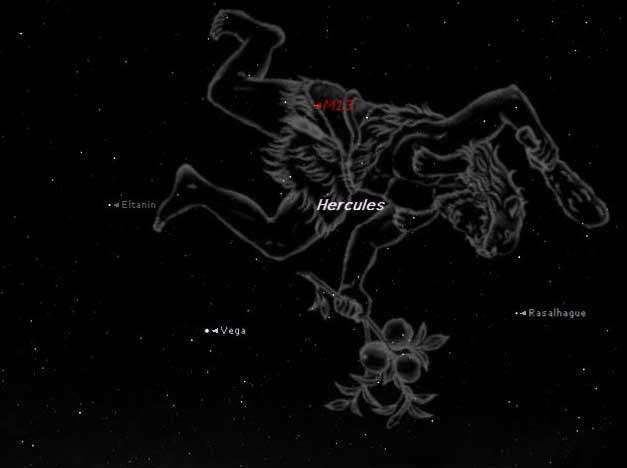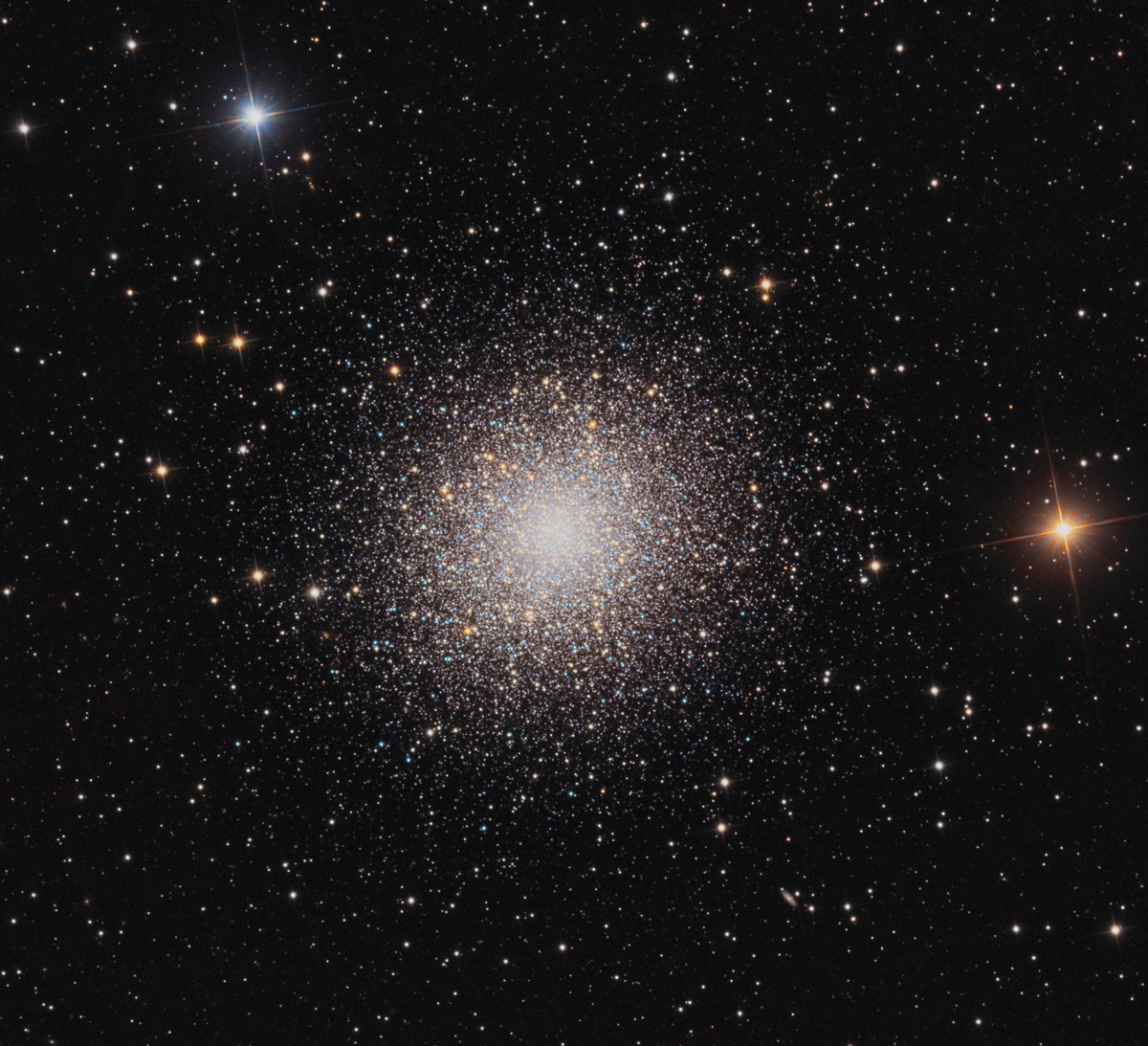Look for the Great Hercules Kneeling in the Sky This Week

If you look skyward around 11 p.m. local time over the next several days, you'll see an ancient star pattern almost directly overhead: It's Hercules, the mighty strong man and hero of many legends.
The stars that compose the constellation of Hercules are, for the most part, rather dim. I always thought it was rather inappropriate that, for such a powerful figure, his representative star pattern is, to say the least, rather weak. Indeed, it is difficult for modern skywatchers to visualize the mythological figure from this collection of stars.
Astronomer Robert H. Baker (1880-1962) described the constellation's six brightest stars as a "butterfly with outspread wings." Yet, others sometimes describe those same stars as outlining the letter "H" for Hercules. And in his book, "The Stars: A New Way to See Them" (HMH Books for Young Readers, 1976) author H.A. Rey pictured Hercules as a kneeling man swinging a club. [Skywatching in 2015: 9 Must-See Stargazing Events]
Centuries ago, skywatchers seemed to have no difficulty in picturing these stars as forming the figure of a kneeling man, and the old Arabic name of its brightest star, Ras Algethi, literally means "The Head of the Kneeler." One has to wonder, however, if Hercules was a celestial acrobat of sorts, because in our sky, he appears to be upside down, doing a headstand.
Was he a song-and-dance man?
The ancient Greeks declared that "The Kneeler" was, in fact, their great hero, Hercules. But in about 260 B.C., the Greek poet Aratus, in his famous poem "Phaenomena," made no mention of the name Hercules in describing this star pattern. Rather, he stated, "…[N]o one knows how to read that sign clearly, nor on what task he is bent."
The copyist of Aratus' manuscript, in a marginal note, said "The Kneeler" was Thamyris, an early legendary Thracian bard whose misfortunes began when he boasted that his poetry surpassed that of the Muses (the nine daughters of Zeus). The bard's boasts about the Muses being inferior to him backfired badly, when, on his way home, he encountered the nine ladies and they promptly put a curse on him. Thamyris used to sing, play the harp and dance, but the Muses disabled him from all three. And in a final act of revenge, they put his eyes out as well. Perhaps this is why the Kneeler's stars are so dim.
The constellation and Herculean legend may be based on an epic hero of the Sumerians and Babylonians named Gilgamesh, who was half human and half divine.
Breaking space news, the latest updates on rocket launches, skywatching events and more!
A "wonderful chrysanthemum"
Within the constellation Hercules is quite possibly the most celebrated object in the summertime skies: The Great Globular Cluster, also known as M13. The "M" is the initial of the famed French comet observer, Charles Messier (1730-1817). Messier was deeply interested in discovering comets, but he was plagued by the same trouble that besets all comet hunters: He kept finding "comets" that were not comets at all but only star clusters and nebulae. His hopes were dashed so often that, for his own convenience, he kept a list of these deceiving objects, which he published in a catalog.
M13 is the brightest and most dramatic example of a globular cluster north of the celestial equator, often referred to simply as "The Great Hercules Cluster." It's a concentration of more than 100,000 stars, located roughly 23,000 light-years from Earth.
Globular clusters are masses of stars that typically lie on the outskirts of our galaxy. If you have good binoculars, you should have no difficulty in locating M13, for it will appear as a hazy-looking "star" of about sixth magnitude (which is about the threshold of naked-eye visibility). In a small telescope, it will appear as a bright, round nebula about one-third the apparent size of the moon. With a 4- to 6-inch (10 to 15 centimeters) telescope, the round glow begins to become resolved into hundreds of tiny star points. With telescopes 12 inches (30 cm) or larger, you can get a truly memorable view. Baker called it a "wonderful chrysanthemum of stars."
For those who regularly attend the annual Stellafane Convention just outside Springfield, Vermont, (which, in 2015, takes place Aug. 13-16), the Great Hercules Cluster is the object that the 12-inch Porter Turret telescope on Breezy Hill is directed toward most often. Many years ago, the legendary deep-sky observer, Walter Scott Houston (1912-1993) — known to one and all as "Scotty" — noticed a long line of people patiently waiting their turn to get a view through the eyepiece. "What are you folks looking at?" he asked as he poked his head through the observatory door. From out of the darkness, came the response: M13. "M13?" replied Scotty, with a tinge of incredulity. "So many people have looked at it, you would think it'd be worn out by now!"
Joe Rao serves as an instructor and guest lecturer at New York's Hayden Planetarium. He writes about astronomy for Natural History magazine, the Farmer's Almanac and other publications, and he is also an on-camera meteorologist for News 12 Westchester, New York. Follow us @Spacedotcom, Facebook and Google+. Original article on Space.com.

Joe Rao is Space.com's skywatching columnist, as well as a veteran meteorologist and eclipse chaser who also serves as an instructor and guest lecturer at New York's Hayden Planetarium. He writes about astronomy for Natural History magazine, Sky & Telescope and other publications. Joe is an 8-time Emmy-nominated meteorologist who served the Putnam Valley region of New York for over 21 years. You can find him on Twitter and YouTube tracking lunar and solar eclipses, meteor showers and more. To find out Joe's latest project, visit him on Twitter.

